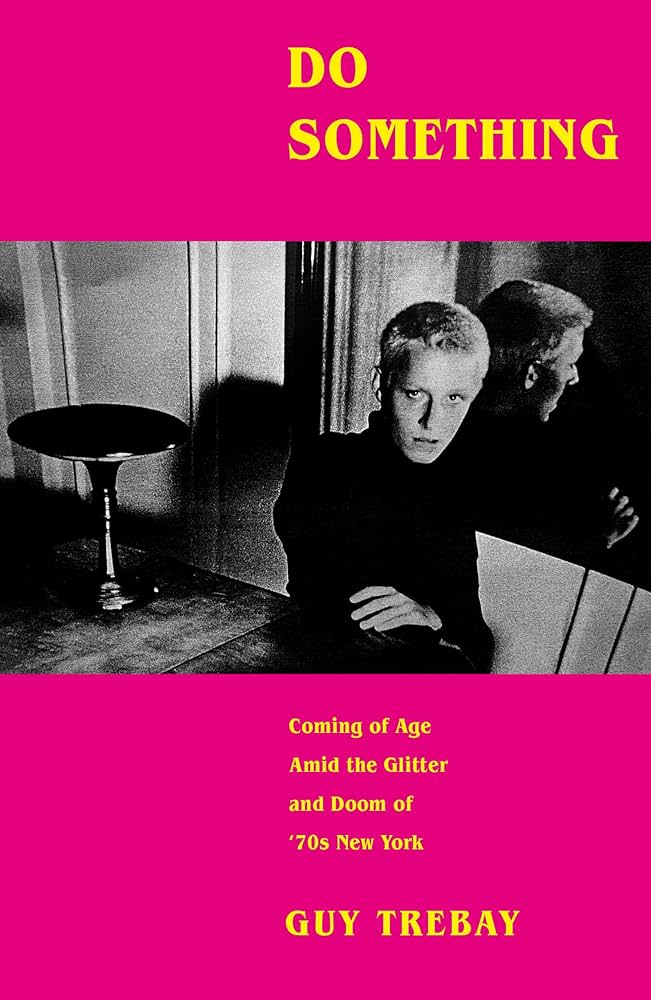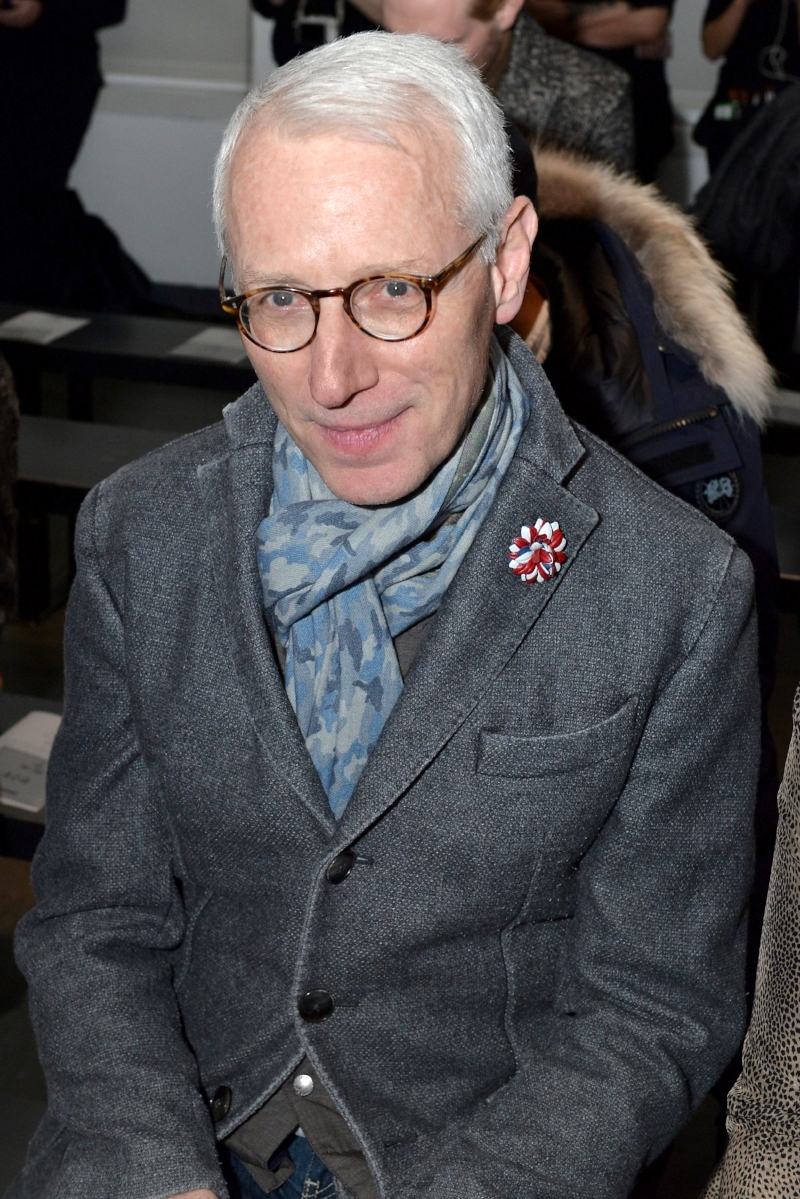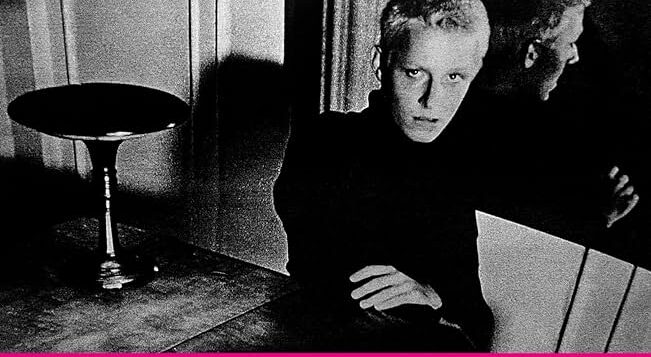 DO SOMETHING
DO SOMETHING
Coming of Age Amid the Glitter and Doom of ’70s New York
by Guy Trebay
Alfred Knopf. 256 pages, $29.
THE HISTORY of New York City in the 1970s is now something of a cottage industry. It’s not just Andy Warhol; it’s memoirs like that of Patti Smith about her friend Robert Mapplethorpe and his mentor Sam Wagstaff; or the recent biography of Candy Darling; or the fact that the photographs of Peter Hujar are on exhibit at the Venice Biennale. The epicenter of this cultural era may remain Warhol and the Factory, but now less famous figures are being given their due. The latest in this excavation of the late ’60s and ’70s demimonde comes from Guy Trebay, who’s now a reporter for the “Styles” section of The New York Times covering men’s fashion.
The subtitle of his memoir (Coming of Age Amid the Glitter and Doom of ’70s New York) captures how the ’70s are now viewed—as New York City on the skids. When President Ford refused the city’s request for a financial bail-out in 1975, the headline on the front page of The Daily News was “FORD TO CITY: DROP DEAD.” Crime was up, the middle class was fleeing to the suburbs, and Johnny Carson seemed to take special pleasure in the city’s incompetence in plowing the streets after a snowfall, before The Tonight Show moved to Los Angeles. But rents were low and eccentrics abounded, and all sorts of art was being created—a heady time in which to come of age, despite the poverty and perils that make Trebay’s an almost Dickensian saga.
The book opens, however, more like Daphne Du Maurier’s Rebecca.
Trebay describes running wild while his family lived on Long Island, the son of two parents he describes as “children raising children”: taking drugs, letting his hair grow long, losing his virginity to a girl at fifteen in her father’s car, and shoplifting “anything that was not nailed down.” Every Christmas morning the family would open presents and then go to the airport and fly off to places like Antigua. But after a close friend of his father swindles him out of his fortune, the family has to move back to their point of origin: the Bronx. Still, it’s the premature death of his mother while still in her forties that shatters the family. Trebay drops out of high school and moves into the city—the only part of New York he can afford, the South Bronx. The Bronx in a way haunts this book, a place where great wealth (the north part) and great poverty (the south) are reflected in very different racial demographics. But it also has affordable rents that allow Trebay to commute to Manhattan and search for what he really wants to do in life.
At this point, Manhattan is still a curious mix of the ’50s and ’60s. You can still eat at Chock Full o’ Nuts and the Horn & Hardart cafeteria. There are still old movie stars like Garbo walking the streets. Trebay writes a fan letter to Anita Loos (Gentlemen Prefer Blondes) and is invited over for tea. He gets to know artists like Ray Johnson, “the founder of the New York Correspondence School, who signed his relentless mail-art pieces using, among other aliases, the name Cora Spondant.” In a string of bookstores on 4th Avenue south of 14th Street called Book Row, he discovers books by Gore Vidal. He’s friends with Candy Darling, Holly Woodlawn, and Jackie Curtis, who flock to a thrift shop on Second Avenue named Bogie’s to find their outfits. Back in the Bronx, he makes jewelry and handbags that are bought by Henri Bendel and Bonwit Teller. He writes scripts for videos that rarely get made and gets a job at a dance club on the tenth floor of a nondescript building in the West Twenties, where his job is to serve nonalcoholic drinks, empty ashtrays, and refill the bowl of fruit and nuts for people who are mostly on drugs.
The Tenth Floor contains a crowd he’s never seen before: “slick and confident professional gay men who obviously had money. Pines queens, they were called, after the prosperous gay summer colony on Fire Island … a sharp contrast to the penniless bohemians we were running around with—not least because many had taken up bodybuilding, still a relatively new phenomenon at the time.” But this is not his scene. For one thing, he’s ten years younger than they are. For another, he considers himself a “nerd preppy” who doesn’t fit in with the Factory crowd either. He gets a job as a busboy at Warhol’s favorite hangout, Max’s Kansas City, but quits after “an unappetizing glimpse of the famous back room, which to my eyes was less a bohemian paradise than a plywood-paneled high school cafeteria packed with free-loaders desperately sponging off Andy.” Nor, when he gets a job at Warhol’s Interview, is he “swept up into Andy Warhol’s glamorous coterie, as I wished to be.” Like Woody Allen’s Zelig, he pops up in scenes with people more famous than himself. But he cannot find his place in this glittery crowd until he goes to The Village Voice one day to apply for a job as an assistant to the woman in charge of “Listings” and discovers a place where he can get paid for what he really wants to do: write.
This is The Voice during its heyday, when people would line up on Astor Place to get the first issues of the weekly whose ads enabled them to find lovers, apartments, gurus—in ads that the Internet has usurped to the devastation of print journalism. Eventually, The Voice lets him do what he really wants to do—wander around New York with the photographer Sylvia Plachy, searching out curiosities on his real subject of interest: New York. From 1981 to 1993, he writes vignettes for the paper, which are published in book form in 1994. The title—In The Place to Be: Guy Trebay’s New York—says everything you need to know about how he regards his hometown. The only breaks from New York are a harrowing trip to Romania with Plachy and a trip to northern Virginia, where he retreats to a cabin on the grounds of the birthplace of an unnamed Confederate general, presumably Robert E. Lee, where a small memorial to the slaves who kept the plantation running reminds him of the friends he has lost to AIDS.
No one to my knowledge has ever explained how the New York of the ’60s became the New York of the ’70s. This book makes you think about a lot of things like that. How the icon of the city went from Allen Ginsberg reading poems at St. Marks Church in-the-Bowery to Halston designing dresses in Olympic Tower before going to Studio 54 with Bianca Jagger is a mystery. Although Do Something is not analytical or particularly reflective—preferring, I think, to tell the story and let the reader draw their own conclusions—Trebay does capture in wonderful prose the essential things about the sexual playground that Manhattan was during the transition from Doom to Glitter—the emptiness and the danger. He writes:
What is too little remarked on is how somnolent and dreamlike the city could be, how in many ways magical appeared this wrecked and depopulated metropolis, my classroom. Great swaths of the city were desolate. The triangle between Canal Street and the World Trade Center (not yet formalized as “Tribeca”) was so hushed at night as to feel like the abandoned back end of some small town, a place where you could ride a bike down the middle of Hudson Street after dark. Everywhere you ventured were forgotten corners, hidden places; shoreline verges dense with reeds and cattails, abandoned piers; smutty aprons of beach lapped by an even dirtier Hudson; dead-end alleys; parks overgrown with sumac, ailanthus, and other opportunistic weed trees; labyrinthine railway tunnels that were the habitats of feral cats and bands of vagrants who, entering through a secret gate in an overpass off the West Side Highway, descended to honeycombed warrens of concrete niches furnished with castoffs and lighted by candles.
“A Neronian scene” he calls it. Paradise for a young man fleeing family sorrow and wondering how he is to fit in and prosper in life!
His sex life, however, is not mentioned. Although he loses his virginity to a girl when still in high school, his life when he gets to New York City becomes, if not gay, then gay-adjacent. But nothing of heartache, or sexual obsession, is revealed, though sexual indulgence was a huge part of 1970s New York. Gay life is rendered in an almost anthropological way. To quote at length:

What is easy to forget now is that those Factory people were just one faction in the teeming microecology of downtown New York. There were many clans and I seemed for a while to float in and out of most. There was the Halston crowd of friends and rent boys and hangers-on and gorgeous young models and the amputees he occasionally hired to fulfill certain sexual needs, as well as the omnipresent Venezuelan artist and pest Victor Hugo. There was the joyous planetary system revolving around the light of Antonio Lopez, the Bronx-born Puerto Rican fashion illustrator … the posse of male beauties scouted as models by the Hungarian Zoltan “Zoli” Rendessy for his maverick agency Zoli, men like Joe MacDonald and Kalani Durdan and Robert Yoh who would define masculine beauty for a generation. There was the Calvin Klein coterie of newly wealthy and empowered gay professionals with lives that centered around meat-rack weekends at Fire Island Pines. There was a network of art types linked through the matrix of one brooding, truculent and irresistible artist—that is, the photographer Peter Hujar. There were the cult deejays who had only recently begun to transform a hobby into a profession, hauling milk crates of vinyl from one obscure club to another, camp followers trailing behind.
Other things that may seem crucial to the reader are not gone into. It’s hard to say what sort of memoir devotes several pages to how Trebay came up with a penname for the writer Jamaica Kincaid but none to the swindling of Trebay’s father, which would seem to be far more dramatic. Sometimes the principle of selection makes the story hard to follow. There is anger in this book and a lot of sadness, but even they are conveyed mostly in subordinate clauses. To his credit, Trebay writes such beautifully honed sentences that these clauses contain more than most people’s sentences. But one feels a reserve. The book’s tone is at once down-to-earth and ultra-sophisticated, not unlike his essays on culture and fashion in the Times—reserved, strict, sardonic—very Gore Vidal, in a way. But it’s always in the service of his native city.
As for the other element that Trebay associates with ’70s New York, the danger, it’s not just people like Son of Sam. It was in the fact that you knew back then that your life depended, really, on your ability to run. New York in the early ’70s was a place where you never knew if the person you might meet on the next corner would be the love of your life or someone from whom you’d have to flee—as Trebay has to when chased by a mugger with only three steps between them on the stairs to his apartment.
And then there was the real danger, the one nobody knew about, that no one could have known about, because it was already with us long before the first symptoms appeared. Trebay doesn’t write about AIDS any more than he has to, so it’s all the more effective when he says near the end of the book that New York has become for him a “ghost-infested place.” By not belaboring what we already know, he makes the emotional burnout from watching his friends die all the more effective.
“Without being able at the time to articulate the feeling,” he writes, “I had grown soul-sick from attending memorial services … increasingly fearful that, with each corner I turned, I might suddenly find myself face-to-face with some half-dead friends. It happened often.” The dead are still on his mind in the final pages of his memoir as he goes through the contents of his safety deposit box at a local bank in search of a wristwatch his mother wore when she was dying. “I invoke the love I hold for my ghosts as a proxy for a God I have no use for. I sit as I did that day in the quiet cubicle and invoke people like sexy cantankerous Peter Hujar and all the many men in those Super 8 films we made in the mid-seventies, such ones as I know have died, and the heroic friends met then and taken as their adult lives were starting, people whose valor and terror I can never forget.”
From Candy Darling to the Tenth Floor, Do Something is a picture of a New York that no longer exists. (Even the row of bookstores on 4th Avenue just south of 14th Street is gone; only the Strand survives, on Broadway and 10th.) In this sense it is a dark book. Trebay keeps himself, like a good journalist, out of the story, but his memories are a lament for a city and a family that did not survive. It’s a bit like Proust’s In Search of Lost Time.
Temps Perdu means not only time that has passed but also wasted time, the years when you should have been doing something more constructive. But the paradox of both Proust’s novel and Trebay’s memoir is that in neither case was their youth wasted. Proust always knew when, in the eyes of his friends, he was “wasting time” at the salon of Madame Straus that he was doing research for the novel he wanted to write. Trebay’s memoir is about people and places in a city he was exploring that may have seemed pointless at the time but now form the substance of his book. “Do something!” his mother said to him on her deathbed. And so he has.
Andrew Holleran’s latest novel is The Kingdom of Sand. His 1978 novel Dancer from the Dance was set in 1970s New York.






